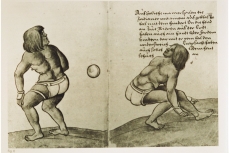

| Ulama players in Toledo, Spain, 1528 Several kinds of ballgames were played in pre-Hispanic "New Spain" as shown by Mesoamerican stone and terracota sculptures, paintings on Maya vases and wall paintings.Architectural variations among ballcourts, some of which have been restored, also point to the existance of different kinds of ballgames, each one having its own symbolic potential From the Classic period ( AD 300-900) on, to the time of the arrival of the Spaniards in Mexico, early in the sixteenth century, the court, called Thachtli in Nahuatl, the language of the Aztecs, consisted of an oblong field with a wider part at each end giving it the shape of a capital I. In all likelihood, originally the game was played on a levelled field without limits marked by walls or earthen curbs In the sixteenth century it must certainly have have still been played everywhere on the central highlands and other Mesoamerican regions, albeit with the necessary modifications because the walls around the court were gone. In these regions, the game lost favour in the course of time, certainly in part because the Spanish priests saw it as a survival of heathen practices and thus prevented it from being played wherever they could. In western and northwestern Mexico, the game continues to be played. Investigations conducted in the 1970's, Ted J.J. Leyenaar observed two types of ballgames, known as ulama de brazo ( or de antebrazo) and ulama de cadera, in the northwestern state of Sinaloa. Some years later, Dr. Leyenaar documented a third form of the surviving ballgame called ulama de palo ( or de mazo). These three modern ballgames, all known by the Aztec name ulama, provide a fascinating glimpse into the Mesoamerican past. The use of the lower arm and hip in games in Sinaloa today is a clear indication of the survival and perpetuation of the pre-hispanic game. None of the ballgames popular in Spain at the time can be seen as a popular precursor. In Sinaloa, Mexico, a prototype of the rubber ballgame has survived in a form without the use of a court with earthen or stone walls. The method of counting rayas or points is practically unchanged. The similarity between the posture of the hip-ulama ballplayer of the Nayarit model-ballcourt and that of today's Sinaloan player points to an extraordinary continuity in the way of playing. All of these elements attest that ulama, in the three forms played today, can be seen as the survival of the Aztec ballgame ullamalitztli. That the Mesoamerican ballgame has survived and flourished for more the 3000 years earns it the distinction of being one of humanity's great cultural expressions |
 |
|
Email us! WATCH A LIVE GAME AS PLAYED TODAY IN SINALOA |
|